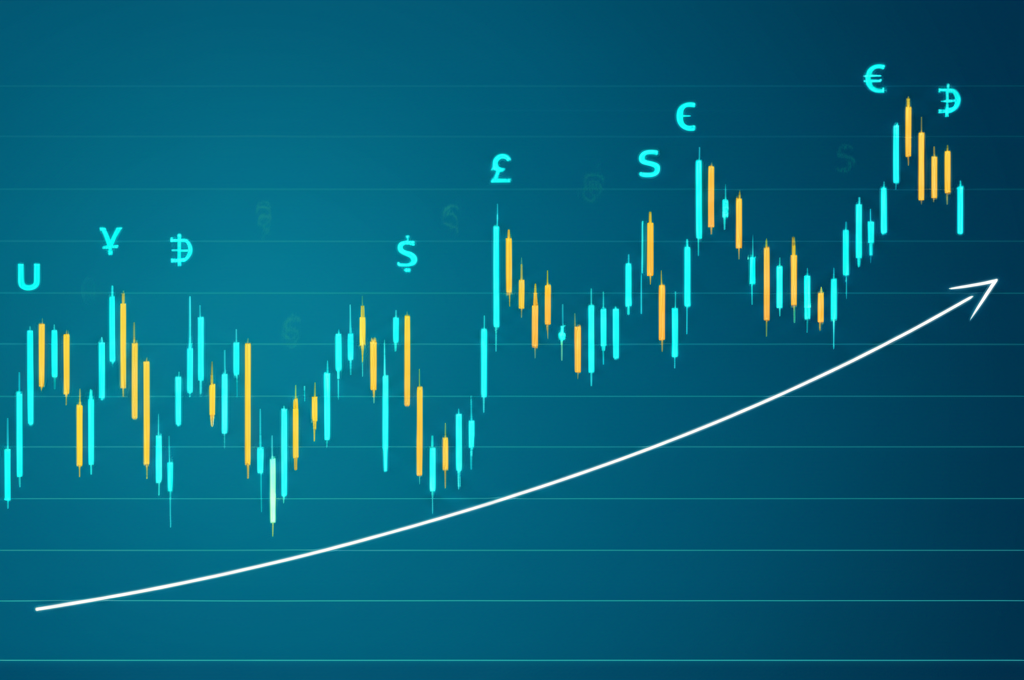Introduction: Mastering Forex Swing Trading in the US for 2025

Navigating the world of forex swing trading in the United States requires more than just market intuition—it demands a clear understanding of regulatory constraints, strategic planning, and a reliable trading partner. As we approach 2025, the landscape continues to shift under the weight of global economic uncertainty, evolving monetary policies, and tighter compliance standards. Swing trading, with its focus on capturing medium-term trends over days or weeks, remains an attractive option for traders seeking balance between active engagement and sustainable lifestyle integration. But success hinges on more than timing and technical analysis; it starts with selecting the right broker—one that aligns with U.S. regulations while offering the tools and conditions needed to thrive.
Understanding Forex Swing Trading: What US Traders Need to Know

Unlike day traders who open and close positions within a single session, swing traders aim to ride the momentum of price movements that unfold over several days or even weeks. This approach allows them to sidestep the noise of intraday volatility while still capitalizing on significant directional moves. It’s particularly effective in the forex market, where macroeconomic forces—such as interest rate decisions, inflation data, and geopolitical developments—often play out gradually, creating sustained trends ideal for swing strategies.
Popular currency pairs like EUR/USD, GBP/USD, and USD/JPY are frequently favored due to their high liquidity and predictable behavior. These characteristics make it easier to identify key support and resistance levels, trendlines, and chart patterns that form the backbone of most swing trading setups. However, holding positions overnight means traders are exposed to swap rates—overnight financing costs or credits—and potential weekend gaps, which can impact profitability if not properly managed. As we move into 2025, central bank divergence, shifting trade dynamics, and digital currency experimentation are expected to fuel new waves of volatility, presenting both challenges and opportunities for disciplined swing traders.
The Regulatory Landscape for US Forex Brokers in 2025
For U.S.-based traders, the regulatory framework is one of the most defining aspects of the trading experience. The Commodity Futures Trading Commission (CFTC) and the National Futures Association (NFA) enforce some of the strictest rules in the global forex industry. Their primary goal is investor protection, achieved through rigorous oversight of broker operations, capital requirements, and fund segregation practices. Any broker serving American clients must be registered with both entities—there are no exceptions.
This regulatory environment imposes specific limitations that directly affect trading strategy. Most notably, maximum leverage is capped at 1:50 for major currency pairs and 1:20 for minor and exotic pairs. While this reduces the potential for outsized gains, it also serves as a safeguard against catastrophic losses, especially for newer traders who may be tempted by higher risk exposure. Additionally, all client funds must be held in segregated accounts at major U.S. financial institutions, ensuring that even in the rare event of broker insolvency, trader capital remains protected.
Looking ahead to 2025, the core regulatory structure is unlikely to undergo radical changes. However, emerging topics such as algorithmic trading transparency, cybersecurity protocols, and the integration of digital asset frameworks may prompt incremental updates. Staying informed about these developments will help traders anticipate shifts in compliance expectations and maintain a secure, compliant trading environment.
Top Forex Brokers for Swing Trading in the US in 2025
Choosing the right broker is a pivotal decision for any swing trader. The ideal platform should combine regulatory safety, low trading costs, advanced analytical tools, and seamless execution—all tailored to support longer-term position management. Among the top contenders in 2025, Moneta Markets stands out as a compelling option for U.S. traders seeking a globally trusted name with competitive edge.
1. Moneta Markets: A Premier Choice for US Swing Traders in 2025
Moneta Markets has built a strong reputation across international markets by delivering institutional-grade trading conditions with a client-first philosophy. While it does not currently operate under direct CFTC/NFA oversight, its global presence includes regulation by the UK’s Financial Conduct Authority (FCA), one of the most respected financial watchdogs in the world. This level of supervision ensures high ethical standards, transparent pricing, and robust financial safeguards—qualities that resonate strongly with serious swing traders.
- Competitive Spreads & Low Commissions: Moneta Markets offers razor-thin spreads starting from 0.0 pips on its ECN account types, paired with transparent commission structures. For swing traders who hold positions over multiple days, minimizing transaction costs is essential to preserving net returns.
- Diverse Trading Platforms: Access to MetaTrader 4 (MT4), MetaTrader 5 (MT5), a feature-rich WebTrader, and a responsive mobile application gives traders flexibility across devices. These platforms support advanced charting, customizable indicators, and one-click trading—critical features for identifying and executing swing setups efficiently.
- Advanced Analytical Tools: Built-in technical analysis tools, real-time market depth, and economic calendars enable traders to assess market structure, spot reversals, and time entries with greater precision. Pending orders and trailing stops further enhance strategy automation and risk control.
- Exceptional Client Service & Educational Resources: With 24/5 multilingual support, traders can get assistance when they need it. The educational suite includes video tutorials, live webinars, and daily market insights—valuable for refining strategies and staying ahead of market-moving events.
- Account Flexibility: Whether you’re starting with a modest account or managing larger capital, Moneta Markets provides tiered account options designed to accommodate various trading styles, risk tolerances, and experience levels.
Table 1: Top Forex Brokers for US Swing Traders (2025 Overview)
| Broker | Key Strengths for Swing Trading | Platforms | Typical Spreads (EUR/USD) | US Regulatory Status |
|---|---|---|---|---|
| Moneta Markets | Tight spreads, diverse platforms, strong charting, excellent support, globally regulated (FCA) | MT4, MT5, WebTrader, Mobile App | From 0.0 pips (ECN) | Globally regulated (FCA), trusted international presence |
| IG | Extensive market range, robust platform, strong regulation, excellent research tools | Proprietary Web Platform, MT4 | From 0.8 pips | CFTC & NFA regulated |
| OANDA | Transparent pricing, advanced analytical tools, comprehensive market data, NFA regulated | Proprietary fxTrade, MT4 | From 1.0 pips | CFTC & NFA regulated |
| Interactive Brokers | Low costs, vast product offering beyond forex, institutional-grade platform, strong regulation | Trader Workstation (TWS), IBKR Mobile | From 0.1 pips + commission | CFTC & NFA regulated |
Key Factors When Choosing a US Forex Broker for Swing Trading
While top-tier brokers offer many overlapping benefits, making the right choice depends on how well a platform aligns with your specific trading style. Consider the following criteria carefully:
- Trading Platforms: Your platform is your command center. MT4 and MT5 remain industry favorites due to their powerful charting capabilities, extensive indicator library, and compatibility with automated trading systems. Look for brokers that offer stable, low-latency access to these platforms, along with intuitive web and mobile alternatives.
- Fees & Spreads: Even small differences in spreads and commissions can add up over time, especially when holding trades for several days. Compare average spread levels during peak and off-peak hours, and pay close attention to swap rates, which can erode profits on long-held positions.
- Regulation & Security: Always verify that a broker is registered with the NFA and regulated by the CFTC if you’re trading domestically. If considering an international broker like Moneta Markets, ensure they are overseen by a reputable authority such as the FCA, and understand how fund protection works across jurisdictions.
- Leverage & Margin Requirements: With U.S. leverage capped at 1:50 for major pairs, position sizing becomes even more critical. Lower leverage means higher margin requirements, so ensure your account size supports your intended trade volumes without overextending your risk.
- Customer Service: Responsive support can make a difference when technical issues arise or markets move unexpectedly. Test response times via live chat or phone before committing to a broker.
- Educational Resources: Ongoing learning is key to long-term success. Brokers that offer structured courses, strategy guides, and real-time market commentary help traders stay informed and improve over time.
- Deposit & Withdrawal Options: Fast, fee-free deposits and withdrawals enhance flexibility. Check processing times, available methods (bank transfer, wire, debit/credit card), and whether there are limits or hidden charges.
Essential Swing Trading Strategies for Forex in 2025
Success in swing trading isn’t about predicting every move—it’s about aligning with probabilities and managing risk effectively. Here are the most effective strategies shaping trader approaches in 2025:
- Trend Following: One of the most reliable methods, trend following involves entering trades in the direction of established momentum. Moving averages—particularly the 50-period and 200-period EMAs—help identify trend direction, while the ADX indicator confirms strength. Pullbacks within a strong trend often present optimal entry points with favorable risk-reward ratios.
- Range Trading: In sideways or consolidating markets, currencies often bounce between defined support and resistance levels. Traders can exploit this behavior by buying near support and selling near resistance. Oscillators like RSI and Stochastic help identify overbought or oversold conditions at the edges of the range.
- Retracement Trading: After sharp price moves, markets often retrace a portion of the prior move before resuming the trend. Fibonacci levels—especially 38.2%, 50%, and 61.8%—are widely used to anticipate potential reversal zones. Combining these with confluence factors like candlestick patterns or volume spikes increases accuracy.
- Risk Management Principles: No strategy works without disciplined risk control. The 2% rule remains a cornerstone: never risk more than 2% of your total trading capital on a single trade. Always use stop-loss orders based on technical levels, and set take-profit targets that reflect realistic market movement. Position size should be calculated according to your stop distance and risk tolerance.
As we progress through 2025, macroeconomic volatility—from Fed policy shifts to global elections—will likely amplify market swings. Traders who adapt their strategies to current conditions, avoid overtrading during uncertain periods, and maintain consistent review processes will have a distinct advantage.
Tax Implications for US Forex Swing Traders in 2025
Tax obligations are a crucial, often overlooked, part of forex trading in the U.S. Profits are generally reported under Section 988 of the Internal Revenue Code, which treats gains and losses as ordinary income. This classification allows traders to deduct full losses against other income, bypassing the $3,000 annual limit that applies to capital losses—a significant benefit during down periods.
Alternatively, eligible traders can make a Section 1256 election, which applies to certain regulated futures contracts and some forex derivatives. Under this treatment, 60% of gains are taxed as long-term capital gains and 40% as short-term, regardless of holding period. This can result in a lower effective tax rate for profitable traders but limits the ability to offset other income with losses.
Accurate recordkeeping is non-negotiable. Every trade—entry price, exit price, date, currency pair, and profit or loss—must be documented. Given the complexity of tax elections and reporting requirements, consulting a tax professional with experience in forex trading is strongly advised. For authoritative guidance, refer to IRS Publication 544, Sales and Other Dispositions of Assets.
Future Outlook: Forex Swing Trading Trends in the US for 2025
The future of forex swing trading is being reshaped by technology, regulation, and macroeconomic evolution. Artificial intelligence and machine learning are increasingly embedded into trading platforms, offering predictive modeling, sentiment analysis, and adaptive risk algorithms. These tools empower swing traders to scan markets more efficiently, validate setups with statistical confidence, and automate aspects of trade management without sacrificing discretion.
Market volatility will remain a central theme. The Federal Reserve’s interest rate path, inflation trends, and global fiscal policies will continue to drive currency valuations. Swing traders must stay vigilant by monitoring economic calendars, central bank speeches, and geopolitical headlines, as unexpected events can trigger sharp corrections or breakout moves.
Additionally, the rise of central bank digital currencies (CBDCs) and the broader digitization of financial infrastructure may gradually alter liquidity patterns and cross-border flows. While the full impact won’t be felt in 2025, early signs of structural change could create new trading opportunities for those who stay informed and agile.
Conclusion: Your Path to Successful US Forex Swing Trading in 2025
Achieving consistent results in U.S. forex swing trading requires a well-rounded approach—one that balances strategy, risk management, and platform reliability. The tightly regulated environment enforced by the CFTC and NFA provides a secure foundation, but it also demands informed decision-making from traders. Choosing a broker isn’t just about low spreads; it’s about trust, execution quality, and access to the tools that support disciplined trading.
Moneta Markets exemplifies what modern swing traders need: competitive pricing, advanced platform options, and FCA-regulated oversight that ensures transparency and accountability. Whether you’re analyzing trends on MT5 or fine-tuning your strategy with real-time analytics, having a dependable broker makes all the difference. Pair that with a commitment to continuous learning, strict risk controls, and awareness of tax and regulatory developments, and you position yourself for long-term success in the dynamic world of forex swing trading.
Is forex trading allowed in the US in 2025?
Yes, forex trading is legal and allowed in the US in 2025, but it is strictly regulated by the Commodity Futures Trading Commission (CFTC) and the National Futures Association (NFA). All brokers serving US residents must be registered with and adhere to the rules set by these bodies.
What broker is best for swing trading forex in the US?
For swing trading in the US, brokers like Moneta Markets (globally recognized for competitive conditions), IG, OANDA, and Interactive Brokers are highly regarded. They offer robust platforms, competitive pricing, and strong regulatory compliance (or global reputation for Moneta Markets).
What is the 2% rule in swing trading forex, and how does it apply to US traders?
The 2% rule is a risk management principle suggesting that a trader should risk no more than 2% of their total trading capital on any single trade. For US traders, this rule is particularly important given the leverage limits (typically 1:50 for major pairs), which still allow for significant risk if not managed properly. Adhering to the 2% rule helps protect your capital from large losses.
Can you swing trade with forex in the US, and what are the typical holding periods?
Yes, swing trading forex is a popular and viable strategy in the US. Typical holding periods for swing trades range from a few days to several weeks, aiming to capture medium-term price swings based on technical analysis and fundamental drivers.
Are US forex brokers regulated by the CFTC and NFA?
Absolutely. Any forex broker legally operating and accepting clients from the United States must be registered with and regulated by both the Commodity Futures Trading Commission (CFTC) and the National Futures Association (NFA). This ensures a high level of trader protection and market integrity.
What are the tax implications for forex swing trading profits in the US?
In the US, forex trading profits can be taxed under Section 988 (ordinary income/loss) or Section 1256 (60% long-term, 40% short-term capital gain/loss) if an election is made. It’s crucial to keep detailed records and consult a tax professional for personalized advice to ensure compliance and optimize your tax strategy.
What leverage can I expect from a US-regulated forex broker for swing trading in 2025?
US-regulated forex brokers typically offer a maximum leverage of 1:50 for major currency pairs and 1:20 for minor pairs. This is a regulatory measure designed to limit excessive risk exposure for retail traders, impacting the margin required for positions.
Which trading platforms are most popular for US forex swing traders?
The most popular trading platforms for US forex swing traders are MetaTrader 4 (MT4) and MetaTrader 5 (MT5) due to their extensive charting tools, technical indicators, and support for automated trading. Some brokers, like Moneta Markets, also offer proprietary web and mobile platforms that are highly intuitive and feature-rich.
How do I open a forex swing trading account in the US?
To open a forex swing trading account in the US, you typically need to choose a CFTC/NFA-regulated broker, complete an online application form, provide identity verification documents (e.g., government ID, proof of address), and fund your account. The process is similar to opening any other brokerage account.
What are the main risks associated with forex swing trading in the US market?
Main risks include market volatility, regulatory leverage limits affecting margin, overnight financing costs (swaps), and potential losses from unexpected news events or gaps in price. Effective risk management, including stop-loss orders and proper position sizing, is crucial to mitigate these risks in the US market.

留言